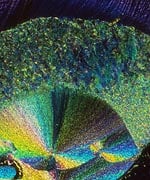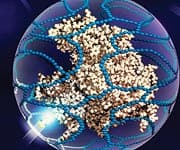Life Extension Magazine®
For years, scientists have sought a way to boost one of the body’s most powerful natural antioxidant enzymes: superoxide dismutase (SOD). Present both inside and outside cell membranes, SOD is one of the body’s primary internal antioxidant defenses, and plays a critical role in reducing the oxidative stress implicated in atherosclerosis and other life-threatening diseases. Studies have shown that SOD can play a critical role in reducing internal inflammation and lessening pain associated with conditions such as arthritis.
Until recently, attempts to supplement with oral preparations of pure SOD enzyme proved disappointing, since the SOD protein molecule is easily deactivated by harsh acids and enzymes contained in the digestive tract.1,2 Scientists have conquered these challenges by creating bioavailable forms of SOD using natural plant extracts.
When delicate SOD molecules are coupled with a protective protein derived from wheat and other plants, they can be delivered intact to the intestines and absorbed into the bloodstream, thus effectively enhancing the body’s own primary defense system.2-5 Once in circulation in the bloodstream, these powerful antioxidants go to work detoxifying potentially harmful substances and reducing oxidative stress that might otherwise contribute to aging and crippling diseases such as atherosclerosis, stroke, and arthritis.
By strengthening the body’s primary antioxidant systems, novel SOD-boosting supplements may offer the most powerful free radical protection available today.
The antioxidant enzymes produced within our bodies are complex proteins that often incorporate minerals such as selenium or zinc in their intricate structures. These antioxidant enzymes serve as the body’s most potent defense against free radicals and ensuing inflam-matory reactions. They include glutathione peroxidase, catalase, and perhaps the most important internally generated antioxidant of all: superoxide dismutase (SOD).
In the liver, enzymes such as glutathione peroxidase act as catalysts, facilitating reactions that render toxins less harmful.6
What you need to know
An enzyme known as superoxide dismutase (SOD) is one the body’s most powerful antioxidants. Although there are ways to boost SOD production, until recently there had not been an effective oral SOD supplement. All that has changed with the development of an SOD/wheat gliadin formulation that resists degradation by stomach enzymes and reaches the bloodstream intact.
Some of the most potentially harmful substances in the body are not toxins that enter from the external environment, but rather internally generated pro-oxidants. While oxygen is essential for life, its use comes at a cost, as it poses a potential threat to biological systems. Accordingly, living systems require an entire system of compounds dedicated to neutralizing oxygen’s harmful effects.
The Dual Nature of Oxygen
Specialized functional compartments within our cells utilize oxy-gen, in combination with other molecules, to generate the energy that powers many biochemical processes. Without oxygen, we could not exist. However, in the process of generating energy by “burning” nutrients with oxygen, certain “rogue” oxygen molecules are created as inevitable byproducts. Known as free radicals and reactive oxygen species, these unstable, highly reactive molecules play a role in cell signaling and other beneficial processes when they exist in benign concentrations.7 But when their numbers climb, as may occur as a result of aging and other conditions, they may wreak havoc with other molecules with which they come into contact, such as DNA, proteins, and lipids. As such, these “pro-oxidant” molecules become especially toxic.
In fact, a prevailing theory of disease and aging states that the gradual accumulation of pro-oxidant molecules, and the harm they incur, is responsible for many of the adverse changes that eventually cause various diseases. These include cancer (possibly triggered by free radical-induced damage to cellular DNA) and inflammatory and degenerative diseases such as Alzheimer’s, arthritis, atherosclerosis, and diabetes.8-13 While scientists have not yet reached consensus on the topic, accumulated evidence overwhelmingly identifies increased oxidative stress with age as a source of damage to cellular structure and function.14
As another example, consider the visible effects of free radical damage to collagen, which forms the skin’s “scaffolding.” Healthy collagen is responsible for the skin’s elasticity and, to no small degree, its youthful appearance. As we age, internally generated reactive oxygen species gradually damage the molecular structure of collagen, eventually producing outward signs of aging such as skin wrinkling and sagging. For the first time, scientists at the University of Aarhus in Denmark have shown that SOD plays an important role in preventing this damage from occurring.
The Danish researchers discovered that SOD binds directly to collagen, which it protects from oxidation. Reporting in the Journal of Biological Chemistry, they noted that superoxide dismutase significantly protects type I collagen from oxidative breakdown. Furthermore, they noted this interaction may play an essential physiological role in preventing fragmentation of collagen during oxidative stress.15
Disarming Superoxide Radicals
Superoxide dismutase is arguably the body’s most crucial antioxidant, as it is responsible for disarming the most dangerous free radicals of all: the highly reactive superoxide radicals. Superoxide radicals, or anions (negatively charged atoms), are produced when oxygen gains an excess electron. This occurs through normal metabolic processes, such as the catalytic transformation of various molecules by enzymes.
SOD is responsible for catalyzing the conversion of superoxide to elemental oxygen and hydrogen peroxide. This transformation is called dismutation, hence the enzyme’s name. Although hydrogen peroxide is also a pro-oxidant compound, it is subsequently converted by the enzymes catalase and glutathione peroxidase to simple water and oxygen.11
Superoxide and Degenerative Disease
Although SOD’s benefits go beyond the mere neutralization of superoxide anions, the threat of exposure to superoxide should not be underestimated. Superoxide anions are strongly implicated in the development of numerous degenerative diseases, including atherosclerosis, stroke, heart attack, chronic and acute inflammatory conditions, and various other age-related disorders.16
For example, scientists at the University of Pittsburgh note that overproduction of reactive oxygen species is associated with the development of conditions ranging from cardiovascular disease to neurological disorders and lung pathologies. According to these scientists, SOD is an ideal candidate for preventing cell and tissue damage initiated by reactive oxygen species such as superoxide.17
A Texas neuroscientist noted that chronic pain associated with inflammation appears to be mediated by superoxide. Conversely, experiments have shown that pain is decreased when superoxide is neutralized.18 Arthritis is another condition in which superoxide is implicated. Korean researchers demonstrated that SOD and glutathione peroxidase are significantly less active in rheumatoid arthritis patients than in normal control subjects. Not surprisingly, dietary intake of antioxidants was also lower among arthritis patients than among controls.19 Superoxide also wreaks havoc by reacting with nitric oxide to form peroxynitrite, another highly reactive molecule that subsequently induces cellular and tissue injury. Peroxynitrite is implicated in several diseases, including stroke, Alzheimer’s, and atherosclerosis.20
Americans spend billions of dollars each year on pharmaceuticals designed to lower cholesterol and thus avert atherosclerosis. However, one research team recently pointed out that low SOD levels may play a greater role than elevated cholesterol in the development of this life-threatening condition. According to the researchers, diminished levels of SOD and total antioxidant status may well play a larger role in the development of atherosclerosis than isolated elevations in total cholesterol or triglyceride levels.21
Natural Ways to Boost SOD Levels
Given the connection between superoxide and illness, scientists have long sought ways to boost SOD levels in order to combat oxidative damage and reduce the incidence or severity of disease. As one research team noted in a recent journal article, SOD may be an effective antioxidant therapy for managing the detrimental consequences of inflammatory diseases, as well as for mitigating other conditions associated with uncontrolled overproduction of superoxide.22
In the 1980s, scientists attempted to treat osteoarthritis by injecting SOD derived from the blood cells of livestock directly into diseased joints. Relief from inflammation was often dramatic in these early experiments, as the injected SOD scavenged and neutralized pro-inflammatory superoxide anions. This technique was far from practical, however, and was never embraced as a viable treatment for human patients.23
Efforts to boost SOD levels did not stop there, however. Turning to nature, scientists discovered that SOD and other primary antioxidants—like glutathione peroxidase and catalase—are produced by certain plants, including the sprouting seeds of crops such as wheat, corn, and soy. These young grains harbor an abundance of powerful antioxidants, which may serve to protect the fledgling plants from various environmental insults. Melons also manufacture some of these antioxidant proteins, and fruits with the highest concentrations of these beneficial enzymes have significantly longer shelf lives.
Some plants produce SOD naturally. However, when SOD is ingested in the body, it is quickly destroyed by stomach acids and intestinal enzymes, and virtually no SOD enters the bloodstream. Fortunately, it is possible to boost levels of this important antioxidant by consuming supplements that supply concentrated amounts of appropriate precursor molecules. Wheat sprouts represent one rich source of these SOD-boosting building blocks, and have been shown to significantly increase internal antioxidant levels.
Scientists have proposed that elevated levels of one form of glutathione, the enzyme glutathione reductase, may serve as a predictor of longevity.24,25 Falling levels of glutathione are associated with diseases such as AIDS, respiratory diseases and infection, osteoarthritis, Alzheimer’s, and even aging itself.26-33 Conversely, increased levels of glutathione are associated with improvements in these conditions.
Benefits of Wheat Sprout Enzymes
Wheat sprout enzymes are another source of bioactive plant flavonoids, and their potential benefits range from improving symptoms of fibromyalgia and joint pain to increasing energy and relieving symptoms of chronic fatigue syndrome. These benefits are likely related to the presence of several potent natural antioxidant enzymes, including superoxide dismutase (SOD), glutathione peroxidase, and catalase.
Consuming wheat sprout extract is an excellent way to increase one’s levels of natural antioxidant enzymes. The sprouting process promotes increased enzyme activity,34 which makes grain sprouts ideal for human enzyme enhancement. Italian researchers recently published an analysis of the antioxidant content of wheat sprout extract, noting that “catalase and peroxidase activity appears very strong.”35 They also reported that biologically active substances from wheat sprout can be at least partially absorbed during the digestion process.35 Italian scientists compared the antioxidant activity of wheat sprout extract to known pure antioxidants such as ascorbic acid, quercetin, and reduced glutathione, and found that the oxygen superoxide-scavenging activity demonstrated by wheat sprout extracts is comparable to that of pure antioxidant compounds.”36
Research has also demonstrated that sprout enzymes possess powerful anti-mutagenic properties—that is, they help prevent mutations that may lead to the development of cancers.37,38 According to unpublished research compiled by scientists at the University of Hawaii, in a survey of 120 subjects who ingested large amounts of plant-based antioxidant enzymes, 88% reported increased energy and 72% reported feeling stronger. Eighty-two percent of survey respondents reported feeling better overall after supplementing with sprout-derived antioxidants.39
Formulating Bioavailable SOD
SOD is a large molecule that, when orally consumed, is not readily absorbed by the body. However, technological advances have enabled scientists to bond SOD (extracted from a type of cantaloupe melon that naturally produces high levels of the enzyme) to a biopolymer extracted from ordinary wheat. Studies have shown that the wheat component, known as gliadin, protects the fragile SOD molecule from the ravages of stomach acid and intestinal enzymes, thus allowing the molecule to enter the bloodstream intact.
The success of this novel pairing has been demonstrated in animal and human studies. Experiments in France showed that SOD/gliadin—but not SOD alone—caused a significant increase in circulating antioxidant enzyme activities when consumed by laboratory rodents. This increase in SOD was associated with an increased resistance of red blood cells to oxidative stress-induced rupture, according to the researchers.2
In another experiment, the French team examined the antioxidant and anti-inflammatory properties of SOD extracted from melon, in both laboratory cell studies and live animals. Their studies showed that the antioxidant properties attributed to the melon extract were indeed due to active SOD. The SOD prompted immune cells (macrophages) to release the anti-inflammatory cytokine interleukin-10 rather than inflammatory tumor necrosis factor, which the cells may release under conditions of oxidative stress. Subsequent studies of live animals showed that SOD levels increased when SOD/gliadin was administered orally. This led the scientists to conclude that it is possible to elicit the pharmacological effects of this antioxidant enzyme in animal subjects.3
More recently, Japanese scientists studied the effects of oral SOD/ gliadin on tumor development in laboratory rodents. Gliadin alone, or the SOD/gliadin combo, was administered orally to test animals before and during experimental tumor induction. About 80% of gliadin-only subjects developed tumors, but only about half as many animals in the SOD/gliadin group did so.
Furthermore, tumor cells from the group that did not receive the SOD/gliadin supplement exhibited signs that they would readily spread, or metastasize. By contrast, tumor cells from animals in the SOD/gliadin group showed decreased metastatic ability. In their report published in the British Journal of Cancer, the Japanese researchers noted that orally active SOD prevented tumor progression promoted by inflammation, and that it may have elicited these effects by scavenging the inflammatory superoxide anion.40
To test the hypothesis that SOD/gliadin improves antioxidant defenses in humans as well as animals, German scientists subjected 20 volunteers to an hour of hyperbaric oxygen treatment. During the procedure, 100% oxygen was forced into the bloodstream at two and a half times the normal atmospheric pressure. Hyperbaric oxygen treatment, though medically necessary on occasion, is known to induce oxidative stress. This stress may be quantified by measuring breaks that occur in strands of DNA and by monitoring levels of isoprostanes, which indicate oxidative damage to cellular membranes. Hyperbaric oxygen treatment is also known to reduce levels of antioxidant enzymes, such as red blood cell SOD and catalase.41 In a randomized, double-blind, placebo-controlled study, scientists demonstrated that supplementation with SOD/gliadin significantly decreased the oxidative damage resulting from hyperbaric oxygen treatment. The investigators found that an orally effective SOD/wheat gliadin mixture can protect against DNA damage, while also preventing elevations in isoprostane levels. These findings suggest that SOD may therefore be considered a powerful antioxidant.4
A previous experiment by another research team also found that hyperbaric oxygen treatment induces breaks in DNA strands. In an effort to reduce this oxidative damage, the scientists administered oral antioxidants such as vitamin E or N-acetylcysteine prior to treatment, but these measures failed to protect against oxidative damage induced by hyperbaric oxygen treatment. This discrepancy would seem to indicate that effective protection against oxidative stress requires increased levels of the primary antioxidant SOD, as opposed to a boost in secondary antioxidant levels.42
Conclusion
Primary antioxidants such as superoxide dismutase are our first and most important line of defense against highly reactive, potentially destructive oxygen-derived free radicals. Researchers believe that SOD decreases with aging,43,44 and evidence suggests that boosting falling SOD levels may help guard against disease and extend life span.45
In the past, it was difficult to raise levels of these beneficial enzymes. Now, however, it is possible to bolster weakened antioxidant defenses with nutritional supplements that include orally bioavailable SOD and other primary antioxidants.
References
1. Regnault C, Soursac M, Roch-Arveiller M, Postaire E, Hazebroucq G. Pharmacokinetics of superoxide dismutase in rats after oral administration. Biopharm Drug Dispos. 1996 Mar;17(2):165-74.
2. Vouldoukis I, Conti M, Krauss P, et al. Supplementation with gliadin-combined plant superoxide dismutase extract promotes antioxidant defences and protects against oxidative stress. Phytother Res. 2004 Dec;18(12):957-62.
3. Vouldoukis I, Lacan D, Kamate C, et al. Antioxidant and anti-inflammatory properties of a Cucumis melo LC. extract rich in superoxide dismutase activity. J Ethnopharmacol. 2004 Sep;94(1):67-75.
4. Muth CM, Glenz Y, Klaus M, et al. Influence of an orally effective SOD on hyperbaric oxygen-related cell damage. Free Radic Res. 2004 Sep;38(9):927-32.
5. Naito Y, Akagiri S, Uchiyama K, et al. Reduction of diabetes-induced renal oxidative stress by a cantaloupe melon extract/gliadin biopolymers, oxykine, in mice. Biofactors. 2005;23(2):85-95.
6. Umulis DM, Gurmen NM, Singh P, Fogler HS. A physiologically based model for ethanol and acetaldehyde metabolism in human beings. Alcohol. 2005 Jan;35(1):3-12.
7. Takeya R, Ueno N, Sumimoto H. Regulation of superoxide-producing NADPH oxidases in nonphagocytic cells. Methods Enzymol. 2006;406:456-68.
8. Barouki R. Ageing free radicals and cellular stress. Med Sci (Paris). 2006 Mar;22(3):266-72.
9. de Magalhaes JP, Church GM. Cells discover fire: employing reactive oxygen species in development and consequences for aging. Exp Gerontol. 2006 Jan;41(1):1-10.
10. Morrow JD. Quantification of isoprostanes as indices of oxidant stress and the risk of atherosclerosis in humans. Arterioscler Thromb Vasc Biol. 2005 Feb;25(2):279-86.
11. Faraci FM, Didion SP. Vascular protection: superoxide dismutase isoforms in the vessel wall. Arterioscler Thromb Vasc Biol. 2004 Aug;24(8):1367-73.
12. Fukai T, Folz RJ, Landmesser U, Harrison DG. Extracellular superoxide dismutase and cardiovascular disease. Cardiovasc Res. 2002 Aug 1;55(2):239-49.
13. Summers WK. Alzheimer’s disease, oxidative injury, and cytokines. J Alzheimers Dis. 2004 Dec;6(6):651-7.
14. Yu BP, Chung HY. Adaptive mechanisms to oxidative stress during aging. Mech Ageing Dev. 2006 Feb 21.
15. Petersen SV, Oury TD, Ostergaard L, et al. Extracellular superoxide dismutase (EC-SOD) binds to type i collagen and protects against oxidative fragmentation. J Biol Chem. 2004 Apr 2;279(14):13705-10.
16. Maier CM, Chan PH. Role of superoxide dismutases in oxidative damage and neurodegenerative disorders. Neuroscientist. 2002 Aug;8(4):323-34.
17. Fattman CL, Schaefer LM, Oury TD. Extracellular superoxide dismutase in biology and medicine. Free Radic Biol Med. 2003 Aug 1;35(3):236-56.
18. Chung JM. The role of reactive oxygen species (ROS) in persistent pain. Mol Interv. 2004 Oct;4(5):248-50.
19. Bae SC, Kim SJ, Sung MK. Inadequate antioxidant nutrient intake and altered plasma antioxidant status of rheumatoid arthritis patients. J Am Coll Nutr. 2003 Aug;22(4):311-5.
20. Shin SG, Kim JY, Chung HY, Jeong JC. Zingerone as an antioxidant against peroxynitrite. J Agric Food Chem. 2005 Sep 21;53(19):7617-22.
21. Zawadzka-Bartczak E. Activities of red blood cell anti-oxidative enzymes (SOD, GPx) and total anti-oxidative capacity of serum (TAS) in men with coronary atherosclerosis and in healthy pilots. Med Sci Monit. 2005 Sep;11(9):CR440-4.
22. Gow A, Ischiropoulos H. Super-SOD: superoxide dismutase chimera fights off inflammation. Am J Physiol Lung Cell Mol Physiol. 2003 Jun;284(6):L915-6.
23. Flohe L. Superoxide dismutase for therapeutic use: clinical experience, dead ends and hopes. Mol Cell Biochem. 1988 Dec;84(2):123-31.
24. Klapcinska B, Derejczyk J, Wieczorowska-Tobis K, et al. Antioxidant defense in centenarians (a preliminary study). Acta Biochim Pol. 2000;47(2):281-92.
25. Andersen HR, Jeune B, Nybo H, et al. Low activity of superoxide dismutase and high activity of glutathione reductase in erythrocytes from centenarians. Age Ageing. 1998 Sep;27(5):643-8.
26. Micke P, Beeh KM, Buhl R. Effects of long-term supplementation with whey proteins on plasma glutathione levels of HIV-infected patients. Eur J Nutr. 2002 Feb;41(1):12-8.
27. Micke P, Beeh KM, Schlaak JF, Buhl R. Oral supplementation with whey proteins increases plasma glutathione levels of HIV-infected patients. Eur J Clin Invest. 2001 Feb;31(2):171-8.
28. Bishop C, Hudson VM, Hilton SC, Wilde C. A pilot study of the effect of inhaled buffered reduced glutathione on the clinical status of patients with cystic fibrosis. Chest. 2005 Jan;127(1):308-17.
29. Carlo MD, Jr., Loeser RF. Increased oxidative stress with aging reduces chondrocyte survival: correlation with intracellular glutathione levels. Arthritis Rheum. 2003 Dec;48(12):3419-30.
30. Cho CG, Kim HJ, Chung SW, et al. Modulation of glutathione and thioredoxin systems by calorie restriction during the aging process. Exp Gerontol. 2003 May;38(5):539-48.
31. Junqueira VB, Barros SB, Chan SS, et al. Aging and oxidative stress. Mol Aspects Med. 2004 Feb;25(1-2):5-16.
32. Lothian B, Grey V, Kimoff RJ, Lands LC. Treatment of obstructive airway disease with a cysteine donor protein supplement: a case report. Chest. 2000 Mar;117(3):914-6.
33. Vina J, Lloret A, Orti R, Alonso D. Molecular bases of the treatment of Alzheimer’s disease with antioxidants: prevention of oxidative stress. Mol Aspects Med. 2004 Feb;25(1-2):117-23.
34. Lorenz K. Cereal sprouts: composition, nutritive value, food applications. Crit Rev Food Sci Nutr. 1980;13(4):353-85.
35. Marsili V, Calzuola I, Gianfranceschi GL. Nutritional relevance of wheat sprouts containing high levels of organic phosphates and antioxidant compounds. J Clin Gastroenterol. 2004 Jul;38(6 Suppl):S123-6.
36. Calzuola I, Marsili V, Gianfranceschi GL. Synthesis of antioxidants in wheat sprouts. J Agric Food Chem. 2004 Aug 11;52(16):5201-6.
37. Peryt B, Miloszewska J, Tudek B, Zielenska M, Szymczyk T. Antimutagenic effects of several subfractions of extract from wheat sprout toward benzo[a]pyrene-induced mutagenicity in strain TA98 of Salmonella typhimurium. Mutat Res. 1988 Oct;206(2):221-5.
38. Peryt B, Szymczyk T, Lesca P. Mechanism of antimutagenicity of wheat sprout extracts. Mutat Res. 1992 Oct;269(2):201-15.
39. SAS Release 32.3 at the University of Hawaii (01335001) by Environmental Health Associates. Keith M. Burchett, Director, Research Division.
40. Okada F, Shionoya H, Kobayashi M, et al. Prevention of inflammation-mediated acquisition of metastatic properties of benign mouse fibrosarcoma cells by administration of an orally available superoxide dismutase. Br J Cancer. 2006 Mar 27;94(6):854-62.
41. Benedetti S, Lamorgese A, Piersantelli M, Pagliarani S, Benvenuti F, Canestrari F. Oxidative stress and antioxidant status in patients undergoing prolonged exposure to hyperbaric oxygen. Clin Biochem. 2004 Apr;37(4):312-7.
42. Dennog C, Radermacher P, Barnett YA, Speit G. Antioxidant status in humans after exposure to hyperbaric oxygen. Mutat Res. 1999 Jul 16;428(1-2):83-9.
43. Andriollo-Sanchez M, Hininger-Favier I, Meunier N, et al. Age-related oxidative stress and antioxidant parameters in middle-aged and older European subjects: the ZENITH study. Eur J Clin Nutr. 2005 Nov;59 Suppl 2S58-S62.
44. Levin ED. Extracellular superoxide dismutase (EC-SOD) quenches free radicals and attenuates age-related cognitive decline: opportunities for novel drug development in aging. Curr Alzheimer Res. 2005 Apr;2(2):191-6.
45. Sampayo JN, Gill MS, Lithgow GJ. Oxidative stress and aging—the use of superoxide dismutase/catalase mimetics to extend lifespan. Biochem Soc Trans. 2003 Dec;31(Pt 6):1305-7.





